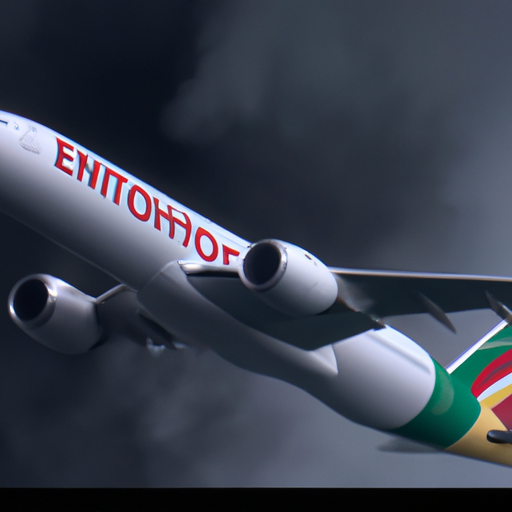
The Impact of Extreme Weather Conditions on Air Travel: Ethiopian Airlines’ Hong Kong Typhoon Flight
Have you ever wondered how extreme weather conditions can affect air travel? Well, let me tell you about an outrageous incident involving Ethiopian Airlines and a typhoon in Hong Kong. This incident highlights the impact that extreme weather can have on the aviation industry.
It all started when Ethiopian Airlines Flight ET609 was scheduled to depart from Hong Kong International Airport. However, a typhoon was approaching the area, causing concern among both passengers and airline staff. Despite the impending storm, the airline decided to proceed with the flight, much to the surprise and outrage of many.
As the plane taxied down the runway, the wind began to pick up, and rain started pouring down. Passengers looked out their windows in disbelief, wondering why the airline would take such a risk. The flight attendants tried to reassure everyone that the pilots were experienced and that they had been given the green light to take off. However, this did little to calm the nerves of the passengers.
Once the plane was in the air, it was immediately clear that the decision to fly was a mistake. The turbulence was intense, and the plane was being tossed around like a toy in the wind. Passengers were gripping their armrests, praying for the flight to be over soon. The flight attendants did their best to provide comfort and assistance, but there was only so much they could do.
Meanwhile, the pilots were struggling to maintain control of the aircraft. The typhoon’s strong winds were making it difficult to keep the plane on course. They had to constantly adjust their flight path to avoid the worst of the storm. It was a nerve-wracking experience for everyone on board.
After what felt like an eternity, the plane finally touched down at its destination. Passengers let out a collective sigh of relief, grateful to have made it through the ordeal. However, their relief quickly turned to anger as they realized the unnecessary risk they had been subjected to.
The incident sparked outrage among passengers and aviation experts alike. Many questioned why Ethiopian Airlines had chosen to fly in such dangerous conditions. They argued that the safety of passengers should always be the top priority, and that the airline had failed in this regard.
In response to the backlash, Ethiopian Airlines issued a statement defending their decision. They claimed that they had followed all necessary safety protocols and that the pilots had deemed it safe to fly. However, this explanation did little to appease the angry passengers.
This incident serves as a reminder of the impact that extreme weather conditions can have on air travel. It highlights the need for airlines to prioritize passenger safety above all else. While it is understandable that airlines want to minimize disruptions and keep their schedules on track, it should never come at the expense of passenger well-being.
In conclusion, the Ethiopian Airlines’ Hong Kong typhoon flight was an outrageous incident that shed light on the impact of extreme weather conditions on air travel. It serves as a reminder that airlines must always prioritize passenger safety, even if it means delaying or canceling flights. Let this incident be a lesson to all airlines to never compromise on safety, no matter the circumstances.
Ensuring Passenger Safety During Challenging Weather Situations: A Case Study of Ethiopian Airlines’ Hong Kong Typhoon Flight

Outrageous: Ethiopian Airlines’ Hong Kong Typhoon Flight
Ensuring Passenger Safety During Challenging Weather Situations: A Case Study of Ethiopian Airlines’ Hong Kong Typhoon Flight
When it comes to air travel, passenger safety is always the top priority. Airlines go to great lengths to ensure that their passengers reach their destinations safely, even in the face of challenging weather conditions. One such example is Ethiopian Airlines’ Hong Kong Typhoon Flight, which showcased the airline’s commitment to passenger safety.
Typhoons are powerful and destructive weather phenomena that can wreak havoc on air travel. With strong winds, heavy rain, and turbulent conditions, flying during a typhoon is not only risky but also requires careful planning and execution. Ethiopian Airlines faced this exact challenge when a typhoon was forecasted to hit Hong Kong, where one of their flights was scheduled to land.
The airline’s response to this impending weather threat was nothing short of extraordinary. Instead of canceling the flight or diverting it to another airport, Ethiopian Airlines decided to proceed with the scheduled landing in Hong Kong. However, they took several precautionary measures to ensure the safety of their passengers and crew.
First and foremost, Ethiopian Airlines closely monitored the typhoon’s progress and worked closely with meteorological experts to gather real-time information about the storm’s intensity and trajectory. This allowed them to make informed decisions about the flight’s timing and route. By staying updated on the weather conditions, the airline could adjust their plans accordingly and minimize the risks associated with flying in a typhoon.
Additionally, Ethiopian Airlines made sure that their pilots and cabin crew were well-prepared to handle the challenging weather conditions. They provided specialized training to their staff, equipping them with the necessary skills and knowledge to navigate through a typhoon safely. This included techniques for handling strong crosswinds, turbulence, and reduced visibility. By investing in their employees’ training, Ethiopian Airlines demonstrated their commitment to passenger safety.
On the day of the flight, Ethiopian Airlines implemented a comprehensive safety plan. They conducted thorough pre-flight inspections to ensure that the aircraft was in optimal condition to withstand the typhoon’s impact. This included checking the integrity of the aircraft’s structure, inspecting the engines, and verifying the functionality of critical systems. By meticulously examining every aspect of the aircraft, Ethiopian Airlines left no room for error.
During the flight, the pilots maintained constant communication with air traffic control and received regular updates on the weather conditions. This allowed them to make real-time adjustments to their flight path, ensuring that they avoided the most severe parts of the typhoon. The cabin crew also played a crucial role in ensuring passenger safety by providing clear instructions and guidance throughout the flight.
Despite the challenging weather conditions, Ethiopian Airlines’ Hong Kong Typhoon Flight landed safely at its destination. The airline’s meticulous planning, comprehensive safety measures, and well-trained staff were instrumental in ensuring the successful outcome of this flight. By prioritizing passenger safety above all else, Ethiopian Airlines set a commendable example for the aviation industry.
In conclusion, Ethiopian Airlines’ Hong Kong Typhoon Flight serves as a case study in ensuring passenger safety during challenging weather situations. By closely monitoring the typhoon, providing specialized training to their staff, conducting thorough pre-flight inspections, and maintaining constant communication during the flight, Ethiopian Airlines demonstrated their commitment to passenger safety. This remarkable example highlights the importance of proactive planning, effective communication, and continuous training in the aviation industry.
Lessons Learned from Ethiopian Airlines’ Hong Kong Typhoon Flight: Improving Emergency Preparedness in the Aviation Industry
Outrageous: Ethiopian Airlines’ Hong Kong Typhoon Flight
When it comes to emergency preparedness in the aviation industry, there are valuable lessons to be learned from Ethiopian Airlines’ Hong Kong Typhoon Flight. This incident, which occurred on September 16, 2018, highlighted the importance of having robust emergency plans in place to ensure the safety of passengers and crew during extreme weather conditions.
The flight in question was Ethiopian Airlines’ ET609, which was scheduled to depart from Hong Kong International Airport to Addis Ababa, Ethiopia. However, as Typhoon Mangkhut approached the region, it became clear that the airline was ill-prepared to handle the situation. Passengers were left stranded at the airport for hours, with little information or assistance provided.
One of the key lessons from this incident is the need for effective communication during emergencies. Passengers on ET609 were left in the dark about the status of their flight, leading to frustration and anxiety. Airlines must have clear and concise communication channels in place to keep passengers informed about any changes or delays. This can be achieved through regular updates via text messages, public address systems, or dedicated customer service representatives.
Another important lesson is the need for contingency plans in the face of extreme weather events. In the case of Ethiopian Airlines’ Hong Kong Typhoon Flight, it was evident that the airline did not have a well-defined plan to handle such situations. Airlines should have protocols in place to assess the risks associated with extreme weather and make informed decisions about flight cancellations or diversions. This includes having access to up-to-date weather information and collaborating with relevant authorities to ensure the safety of passengers and crew.
Furthermore, airlines must prioritize the well-being of their passengers during emergencies. In the case of ET609, passengers were left stranded at the airport without access to food, water, or proper accommodation. This is unacceptable and highlights the need for airlines to have contingency plans in place to provide for the basic needs of passengers during extended delays or cancellations. This can include provisions for food, water, and temporary accommodation if necessary.
Additionally, airlines should invest in training their staff to handle emergency situations effectively. In the case of Ethiopian Airlines’ Hong Kong Typhoon Flight, it was evident that the airline’s ground staff were ill-equipped to handle the situation. Staff should be trained to remain calm, provide accurate information, and assist passengers in a professional and compassionate manner. This can help alleviate anxiety and ensure that passengers feel supported during challenging times.
In conclusion, the Ethiopian Airlines’ Hong Kong Typhoon Flight serves as a wake-up call for the aviation industry to improve its emergency preparedness. Effective communication, robust contingency plans, prioritizing passenger well-being, and training staff to handle emergencies are all crucial aspects that need to be addressed. By learning from incidents like this, airlines can enhance their emergency response capabilities and ensure the safety and satisfaction of their passengers.


